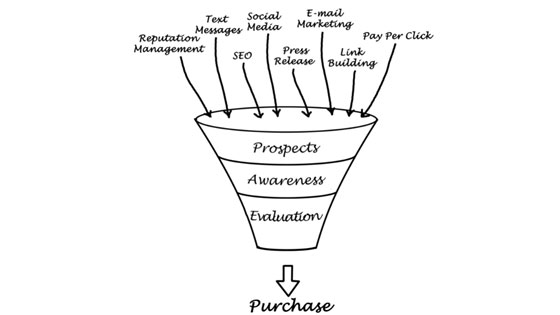Key Marketing Terms For Your Business
November 26, 2021
Marketing for your small business can be tricky when navigating the complex jargon that dominates the marketing industry.
To make things a little easier, we have compiled a list of some common marketing terms so that you can familiarize yourself with the jargon.
Welcome to our digital marketing glossary!

Campaign
A campaign is a unified marketing outreach with a shared message or goal. These will involve marketing activities that have a cohesive style, design, messaging, and outcome.
Target Audience
Your target audience (also known as target market) is the group of people who make up your “ideal customer” or would be the most interested in your products and services. To pinpoint your target audience, you should have a demographical profile of who these people are.
Content Marketing
Content marketing refers to the creation of online content that does not explicitly promote your brand, products, or services. Instead, this content is used to raise your brand’s profile and allow for your business to be seen as experts in your field. Examples of content marketing include informative blog posts or instructional YouTube videos.
Inbound Marketing
Inbound marketing refers to the creation of valuable content that has a positive impact on the viewer to attract potential customers to your website. Through this, you might post an informative blog post related to your field on your website to position your business as knowledgeable and get potential customers interested in your website.
Lead
A lead is when you have a potential customer’s phone number or email address in addition to their consent to contact them. With this, you will engage in the process of lead nurturing, which refers to building a relationship through regular communications (such as an e-newsletter) to convert the leads into customers.
Call To Action
Your call to action is the thing that you want your customers to do after viewing your advertising. This may be to make a purchase, sign up for your newsletter, phone your business, or even just sharing your social media post.

Marketing Funnel
A marketing funnel is the framework that represents the journey a lead goes on before they make a purchase. The top of the funnel is known as the awareness stage, where you are promoting your brand awareness to a wide target audience. Further down the funnel, some of those leads will progress to the consideration stage, where they start to think about purchasing one of your products or services.
At the bottom of the funnel, you have the leads that have converted to your call to action. Some of these leads will only make a one-off purchase, but the very tip of your funnel can represent the loyal customers who keep coming back.
Engagement Rate
Measuring engagement involves comparing how many people are interacting with your marketing against how many people have viewed it. For example, if 100 people have viewed your Facebook post, and it receives 15 likes and two comments, that would equate to an engagement rate of 17%.
However, engagement is relative, and you may consider a lead engaged if they have opened one email from you in the past three months.
Impressions
Impressions are an important marketing metric and refer to the number of times a specific marketing material has been viewed. This is useful information, as it gives you an idea of the reach of your marketing efforts. In addition, if you are finding you are getting lots of views, but not much engagement, that can indicate that your audience is not driven to action by your posts.
Traffic
Traffic is the term used to refer to the amount of people who visit your website. This is a useful metric that can help you determine the number of unique visitors to your website or the number of visitors over a certain period.
Organic (Traffic, Engagement, Followers, and more)
Organic is an adjective to describe people that are viewing or interacting with your marketing efforts without being prompted. An example of this is someone who visits your website without clicking on a Google Ad, or someone who comments on your Facebook posts that are not being promoted.

Bounce Rate
A bounce rate is the percentage of users who leave your website shortly after visiting and do not navigate to any other pages on your website. Your goal should be to keep your bounce rate low by engaging the user and making them want to visit other pages on your website to find out more.
Having a low bounce rate is something that Google takes into consideration when ranking your website in their search results.
Click Through Rate
Your click through rate is the percentage of people who click on a link or button in your marketing materials. This may be the amount of people who click a button on your website to watch your latest YouTube video, or someone who clicks the link to your website on a Facebook ad.
Cost Per Acquisition
Cost per acquisition is a marketing metric that helps identify how much you are spending on your marketing to influence a customer to take a specific action.
Conversion Rate
One of the most important marketing metrics, a conversion rate is the percentage of people who follow through on your call to action.
Customer Lifetime Value
A customer’s lifetime value is a measure of the money you expect to make from a customer over their lifetime by keeping them loyal to your business. This could range from the customer getting a haircut from you every six weeks, to buying a new bike every ten years.

Remarketing
Remarketing is a tactic that you use when a customer was close to making a purchase but did not follow through with it. This could involve showing web advertisements to people who previously visited your website or emailing a customer to let them know they still have items in their cart.
Since the customer was interested previously, this can be effective at getting them over the line to purchase.
SEO
Search Engine Optimisation (SEO) refers to the process of improving your website’s ranking in organic search results. Some examples of this include incorporating keywords into your website copy and publishing new content.
Search Engine Marketing
Search engine marketing refers to paid advertising via search engines that present your website at the top of the search engine results for certain keywords.
Marketing Automation
Marketing automation refers to the use of marketing technologies to automate repetitive admin tasks. This can include software to send follow up emails automatically, track social media analytics, and more.
Style Guide
Having a style guide specifies the font, colour scheme, logos, voice, tone, and writing conventions that must be consistent across all written and marketing material. With this, your marketing materials will look professional and cohesive, and customers will be able to identify that they are from your brand.

Acknowledgement Of Country
Business Foundations acknowledges the traditional custodians throughout Western Australia and their continuing connection to the land, waters and community. We pay our respects to all members of the Aboriginal communities and their cultures; and to Elders both past and present.
Victoria
The Commons
80 Market Street,
South Melbourne VIC 3205
admin@businessfoundations.com.au
Western Australia
Wesley Central
2 Cantonment Street,
Fremantle WA 6160
admin@businessfoundations.com.au


Get In Touch
Have a question or to find out how we can help you, please get in touch.






